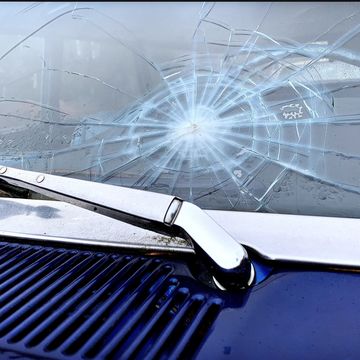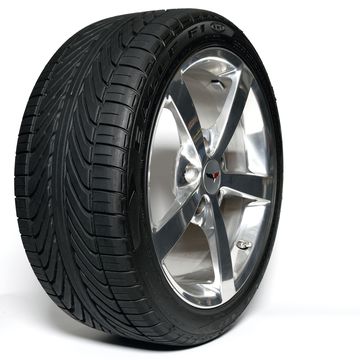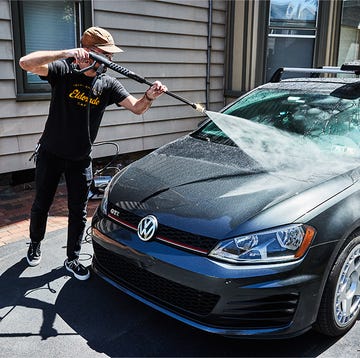22 Brutal Crash Tests That Changed The Way Cars Are Built
Advancements in automotive crash testing over the past few decades have lead to dramatic reductions in injuries. Here are 22 wild crash tests that show how modern vehicles handle the harshest impacts.
By Ben Stewart

Advancements in automotive crash testing over the past few decades have lead to dramatic reductions in injuries. Here are 22 wild crash tests that show how modern vehicles handle the harshest impacts.
1
2009 Chevy Malibu vs. 1959 Chevy Bel Air
Not long ago, classic car lovers assumed that their heavy land yachts were far more protective during a crash than the lighter, smaller cars of today. Watch this video of a crash between a 2009 Chevy Malibu and a 1959 Chevy Bel Air, staged by the Insurance Institude for Highway Safety (IIHS), and that notion explodes in a smash-up of mangled metal. Without crumple zones, airbags, or even seatbelts, the '59 Chevy simply collapses around the driver on impact, receiving a "Poor" rating in every category. The driver probably would've been killed. Notice how little the instrument panel moves on the Malibu compared to the dash of the Bel Air. This really shows just how far automotive safety has come.
2
Tesla Model S frontal crash test
This NHTSA crash test footage of the Model S isn't dramatic to watch, but that's exactly why this car is impressive. The Model S earned the highest crash test rating NHTSA has ever given a new car. Why so good? Part of the reason is that because the Tesla is an EV, there's no engine up front, and that provides more room for the front of the car to absorb the collision forces. The power of the future is making the car of the future safter.
Advertisement - Continue Reading Below
3
VW Bus
VW sold its third-generation bus, the Vanagon, in the US from 1979-1991. While these buses have a rabid following today, the flat-front vans don't look as though they'd fare very well in a collision. But looking back at this three-part internal VW safety video series, these machines do better in collisions than we would have ever imagined, in part because the VW has a serious "deformation zone" ahead of the driver to take much of the load in a crash.
Towards the end of the video, VW performs the same test with the occupants unbelted. The passengers fly through the front window. Remember: Buckle up.
4
2016 Volvo XC90 off-road crash test
Volvo has long been a pioneer in automotive safety. With the all-new XC90, the company ntroduced a pledge that no passenger in a Volvo would be killed or seriously injured from the year 2020 forward. To help prove just how safe the XC90 is, Volvo demonstrated two very extreme internal tests. This video shows the new family wagon launching into a ditch at 50 mph. The SUV flies through the air and lands tail-first before pitching forward and slamming its nose into the ground. The Volvo, and its crash test dummy occupants, appear to be in surprisingly good shape.
Advertisement - Continue Reading Below
5
2010 Mercedes SLS AMG crash test
It's easy, even fun, to watch a pedestrian family sedan get crushed in a safety test. But a high-dollar exotic? That's just painful to watch.
There are two cool things about this vdieo. One is that it shows just how much work goes into setting up a crash test. Second is something particular to the Mercedes-Benz SLS AMG: Those gullwing doors. Because they open upwards instead of out towards the curb, Mercedes had to engineer them with the ability to detach from the bodywork in a rollover. It's impressive just how quickly and easily those doors detach when they need to.
6
120-mph Ford Focus crash
There is no country in the world that crash-tests cars anywhere near 120 mph. But the British automotive TV show Fifth Gear (not to be confused with Top Gear) decided to find out what would happen to a lowly 1990s Ford Focus if it collided with a barrier at that speed. It's a chilling video to be sure, as this little compact goes from 120 mph to nil in 68 milliseconds.
Advertisement - Continue Reading Below
7
Geely CK Latin American crash test
In 2010, Chinese car company Geely bought Volvo—a brand known for setting safety benchmarks. But judging by the results of this Geely performance in a Latin American government crash test, it should plan log some hours with its brethren in Sweden. The little Geely CK sedan performed so poorly it was awarded zero stars out of five. Zero. Look at how the roof structure simply buckles in under the load of the crash.
Curiously, this Geely had an "Airbag off" switch on the dash even though the car didn't come with airbags. So many questions.
8
Woe the Pinto
The fuel tank of the 1971-1976 Ford Pinto was one of the worst engineering safety missteps in automotive history. In a rear impact, the bolts from the rear axle would puncture the tank, and the fuel filler neck would separate and leak fuel. What would have cost Ford $11 to fix became a national nightmare. People died, and the Pinto wasn't officially recalled until 1978. This NHTSA crash test film from that year proved the Pinto caught fire, and rather spectacularly. It was a scandal that changed automotive design forever.
9
1962 Cadillac vs. 2002 Cadillac crash test
This certainly isn't the most scientific or professional crash test we've seen. And the TV show that performed the test, Stuntbusters, got at least a few of the facts wrong right up front. (A 2002 Cadillac does not have a "big block V8," for instance.) Nevertheless, the cool part of this test comes at the end, when you can clearly see how much intrusion into the passenger cabin the older Caddy sustained. The show's techs placed an accelerometer inside the '62 and it recorded a force equivalent to a car falling 18 stories.
10
F-150 vs. Civic
When a tall truck meets a short car, bad things can happen. But in 2000, Ford voluntarily installed blocker beams in its largest trucks to better align the frames of these trucks with the bumper and crumple zone structure of passenger cars. This video shows an F-150 vs Civic crash done both ways, and reveals how important these blocker beams are.
Advertisement - Continue Reading Below
11
Limo test
How safe was that stretch limo you took to the prom? British TV show Fifth Gear decided to create a rather unorthodox but incredibly frightening bit of footage to find out. The show took old-school Lincoln limo and rigged it to travel into a solid wall head-on at 50 mph. The most interesting part, at least technically, is how well the added "stretched" part of the car held up in the crash. The devastation on the inside only reinforces what we all know—always wear your seatbelt, even when you're riding in style, sipping on the bubbly.
12
School bus crash
Buses and big rigs needs safety crash tests, too. The Indiana Mills and Manufacturing Inc. (IMMI) company has a Center for Advanced Product Evaluation (CAPE) that performs some of these wild impact tests. CAPE uses a 1.9-million pound block (!) to crash-test stuff that would destory ordinary crash test equipment.
Side note: IMMI manufacturers seatbelts for school buses, but incredibly, only six states require these buses to have seatbelts. You want to know why that's insane? Watch this school but crash test, and then call your congressperson.
Advertisement - Continue Reading Below
13
Side impact
The first-generation Chevy Colorado midsize trucks certainly weren't bad from a safety standpoint. As this Consumer Reports narrated video shows, they did well in the offset front impact crash tests. During side impact tests, though, they didn't fare so well—without the optional side airbags, the Colorado earned a "Poor" rating. And that's the case with many vehicles that weren't equipped with side impact airbags. The new 2015 Colorado comes standard with front and rear head curtain airbags as well as seat mounted torso bags.
14
Small cars struggle
The new IIHS Small Overlap Test added to the regimen in 2012, basically simulates what would happen if a car were to hit an object like a telephone pole or tree with only part of the front of the car—a small overlap. Some manufacturers did well almost across the board. But generally, the test required automakers to re-engineer the front of their cars to take this severe impact. That first year, the smallest cars did the worst—the Chevy Spark was the only one in the group to handle it well. You can bet that the next generation of all these mini-cars will perform better than they did in 2012.
Advertisement - Continue Reading Below
15
Old Volvo, new test
As we saw earlier, Volvo subjected the all new for 2016 XC90 to some fairly serious internal crash tests. But how would its older design—an ancient crossover SUV model that hadn't been updated since 2002—stand up to this new small overlap test, which directs all the force of a 40 mph barrier collision into just one portion of the front crash structure? The old car scored a "Good" and went on to earn IIHS's Top Safety Pick Plus award. So if you bought this vehicle during its 2002-2015 life cycle, you should feel good that Volvo's safety reputation isn't just marketing hype.
16
Truck fail
Ever notice those under-ride guards built into the back of trailers on 18-wheelers? They're designed to keep passenger cars and light trucks from sliding underneath the trailers. Well, it turns out they don't work so well. As seen in this IIHS video, the results of a 2011 test show that these guards simply buckle under load and break away. Thankfully, many trailer manufacturers are working to equip new models with guards that pass the IIHS test.
Advertisement - Continue Reading Below
17
Big rig barrier crashes
Cruising down the freeway in the left lane, you might glance at the narrow barrier separating you from the opposing traffic flow and wonder whether it could really protect you from an out-of-control 18-wheeler crossing over into oncoming traffic. Well, this video of a 36-ton-truck travelling at 50 mph shows that these barriers work incredibly well to keep big, heavy, and fully loaded trucks in their lane when a driver loses control.
18
Vintage Chevy crash tests
Maybe it doesn't have the sterling safety reputation of a Volvo, but Chevrolet has been crash-testing cars since the 1930s, and in the 1950s it introduced an icon: crash test dummies that measure the impact of a collision. GM's Hybrid II crash test dummy was so advanced at the time (the 1970s) that the US Government decided to use it as the standard for the industry. Here's some great footage of early Chevy crash tests.
Advertisement - Continue Reading Below
19
Big vs. small, 1970s style
Mass usually wins in automotive accidents. And while today's smallest cars come armed with plenty of airbags to help occupants survive in serious car wrecks, the economy cars of the 1970s weren't quite as stout. This vintage film from 1971 shows frontal impacts between the smallest cars and largest ones from a given automaker. As you might imagine, small cars from Ford and Chevy (the Pinto and Vega) aren't great performers. You can see the structure of these machines fold when impacted by larger sedans. However, give some love to the AMC Gremlin. Though it made Time Magazine's dubious worst cars of all time list a few years ago, it appears to perform better than the competition here. Part of the reason is that the Gremlin was built on the chassis of the more stout Hornet.
20
Tata Nano global NCAP crash test
Tata Motors made a lot of news when the company announced the Nano back in 2008. It was to bethe cheapest car in the world, one you could own (although not here in the US) for around $2,000. The Nano was certainly small and inexpensive, but one of the reasons it was so cheap was that it was a terrible performer in crash tests. It received zero stars.

Ben is a lifelong enthusiast of anything with wheels. He has been contributing to Popular Mechanics for nearly 20 years and lives in Venice with an eclectic collection of vintage pickup trucks, muscle cars, and motorcycles scattered in various garages around SoCal.
Watch Next

Advertisement - Continue Reading Below
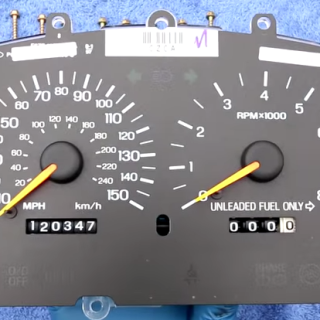
How to Fix a Broken Odometer

Tesla Trade-Ins Nearing Record Highs
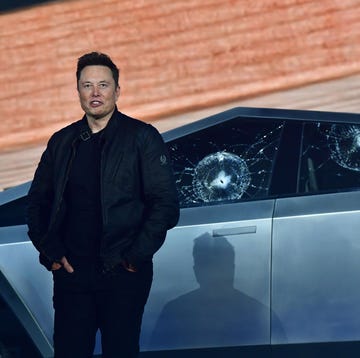
Nearly All Cybertrucks Recalled

Automakers are Pumping The Brakes On EV Targets
Advertisement - Continue Reading Below
Advertisement - Continue Reading Below

